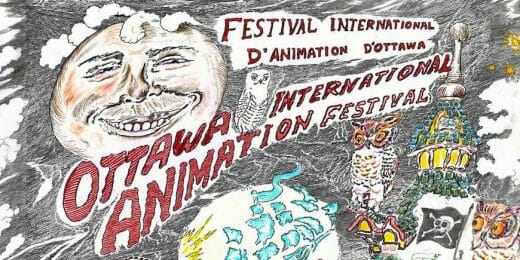
The Throne is an animated comedy that mixes the grandeur of medieval fantasy with modern humor through the animated adventures of a knight. Directed and crafted by Roy el Khawand and a dynamic team of young animators from ECV Bordeaux, this short film offers a fresh take on a familiar genre. A senior animation student specializing in 2D Animation, Roy leads the project alongside 2D FX artist Rozenn Chalons, background artist Emma Ducouvent, storyboard artist Clara Julien and 2D animator Leeloo Soules-Brandier. Together, they are creating an historic yet comedic narrative, combining their shared love for the Middle Ages period of history to create a promising animated universe that we can’t wait to see more of.
Their protagonist’s story is fraught with hilarious obstacles that make for highly comic storytelling that turns the classic hero’s journey on its head. While still in its conceptual phase, their animation style promises to captivate audiences with pose-to-pose techniques that emphasize expressive keyframes and minimal in-betweens. This plays out in a medieval setting, brought to life in beautifully crafted concept imagery and rich background art. With many visual gags to get right, the team used Storyboard Pro to create a comedic cadence that gives the short its well-paced rhythm and flow.
We spoke to Roy who shared he and his team’s experience putting The Throne together. We learn of the techniques and teamwork they employed to get it made, plus some of the unique challenges that come when teaming up with friends as collaborators. We hear of towering castles, unnerving artwork, ermine capes and countless capers that the team concocted to create a short film packed with comic punch!
Hi there, please give an introduction to The Throne…
Roy: The Throne is an animated comedy short film set in Medieval times. The story follows a fanatically neat and slightly pompous Knight who’s in the middle of a battlefield. War is raging all around him and he looks tired and weary. After cutting in half an arrow aimed at him, he spots the enemy King’s chambers at the top of the highest keep of the castle, towering over the battlefield. He darts towards it and leaves the bloody ground behind him. He wants to reach and kill the King.
Within the castle, the Knight will face atrociously dirty toilets, highly dangerous soldiers, slightly unnerving art, puzzling interior architecture and way too many stairs. He finally reaches his enemy’s chambers. The moment he’s been waiting for. The Knight pushes the King aside, a chubby defenseless little old man, who falls out the window.
Nothing stands between the Knight and what he was looking for all along… the royal water closet. The Knight wanted to relieve himself in the cleanest place possible! Back on the battlefield, the King hits the ground, dead, just as the Knight gets out of the castle, zipping up his pants. He throws himself in the commotion, ready to fight his enemies again.
Introduce yourself and the team and explain your roles on the project…
Roy: My name is Roy, I’m a 28-year-old animation student currently in my fourth year at ECV Bordeaux, getting my master’s degree in 2D Animation and specializing in 2D Animation. I hope to be a 2D Compositor after I graduate.
My teammates are Rozenn, 25 years old, specializing in 2D FX. Emma, 21 has chosen Background Art as her specialization. Clara, 21, is our storyboard artist and finally Leeloo, 21 as well, is our lead 2D Animator.
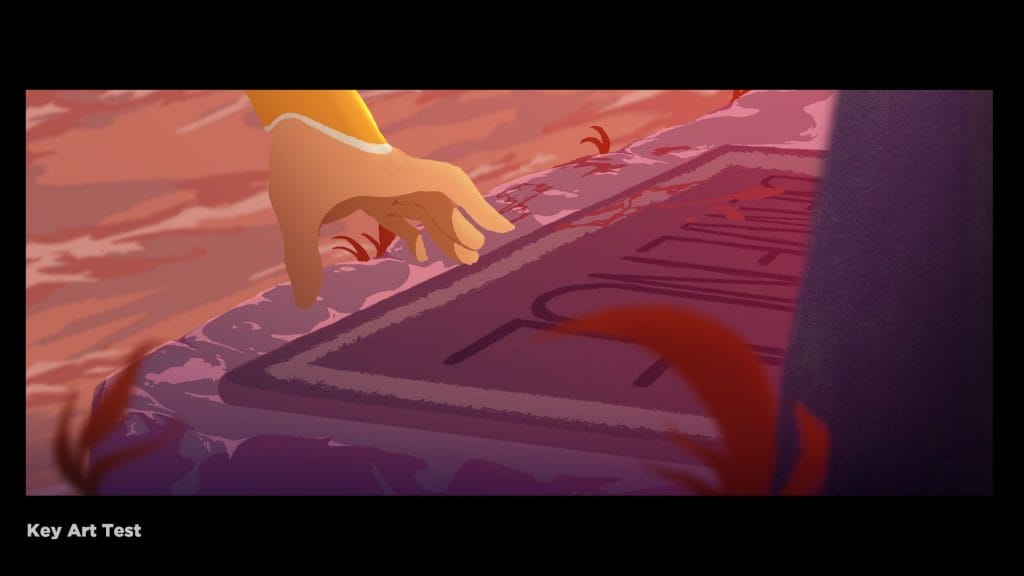
How would you describe the animation style of The Throne?
Roy: Since we’re still in early development stages, I can’t confidently answer this question. We have not yet started doing animation tests but we’re aiming for a pose-to-pose style of animation with very few in-between and a focus on strong posing, expressive keyframes and rich facial expressions.
Please introduce the main characters in the film and explain their design process…
Roy: We have mainly two main characters though we only actively follow one of them. The Knight is a strong, skilled warrior. He dons a very shiny, very golden armor and looks very confident to the point of coming off as pretentious and pompous. His main fault is his clean freakiness. He could face a hundred enemy soldiers, but he can’t bear to get dirty. We needed him to make us laugh and by having these two contrasting sides to him, we’re able to disrupt the Knight in Shining Armor trope we see so much of in books and on-screen.
We therefore decided to go overboard anatomically speaking. He has a slender silhouette with long, skinny legs and an enormous torso, huge pectoral muscles and an oversized armor design, far from being realistic or practical. His hair is platinum blonde and goes with the golden shade of his armor and the creamy white of his garment, emphasizing his neatness and shine and how powerful and special he is. It also renders him absurdly showy, were it in the middle of the battlefield or inside the castle halls.
Our second main character who we only really see at the very end, is the enemy King. Throughout the Knight’s progress up in the castle, many tapestries and paintings will depict this King in various glorious scenes, each exceedingly more epic than the last. The King will look menacing, dangerous, mighty, legendary… Godly even! Only to be revealed as a helpless old man cowering in his bedroom, stuck between the Knight and the water closet door. With the King character, we’re redirecting the Ermine Cape Effect trope wherein a royal figure is always dressed to the nines even though the situation does not require it at all. He meets a quick end and poses no threat at all to our Knight, he’s barely a King at all in the end.
We made him wear an oversized ermine coat (imagine the sleeves flapping in the wind as he falls to his tragic end) and gave him an unusual beard shape to add to his regal appearance. He’s a small, rounded man in his late fifties, strongly contrasting with the tall and slim silhouette of the Knight.
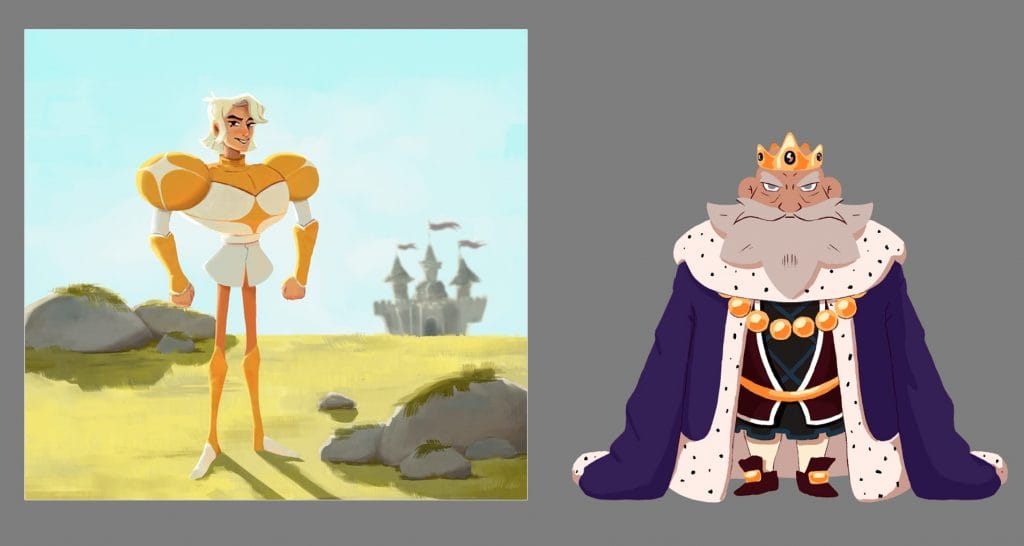
Tell us about the storyboarding process on The Throne…
Roy: When it came to the storyboard, we knew we needed to have a highly dynamic rhythm to our narration. The story beats consist mainly of jokes and gags but the time and space is unusual for a comedy. We tried finding a balance between the majesty of the place and the absurdity of the Knight’s goal.
Clara, our storyboard artist, started sketching the main scenes we all agreed on visually when we were still writing the script and proceeded with filling in the missing scenes in-between, trying out different shots and camera movements. We then discussed what worked and what didn’t before she reworked those intermediary scenes. Her main concern was getting the audience to keep the King in mind, it’s important we don’t forget the Knight is looking for him so that the plot twist at the end is efficient enough.
What inspired you to set your short film in this era?
Roy: Aesthetically speaking, the Middle Ages is a period we’re all fond of. Old, towering castles, armor and swords, kings and queens. Making up a world and its characters set in this era motivates us a lot, especially since we’re doing a comedy. We have an artistic license to play with historical accuracy on every level, insert anachronisms, pop culture references and come up with designs inspired by real-life references but with a twist to them, like a castle in the shape of a toilet seat! We wanted to create a fun adventure with meta jokes and gags that make fun of tropes we often see in epic quests of the Middle Ages.
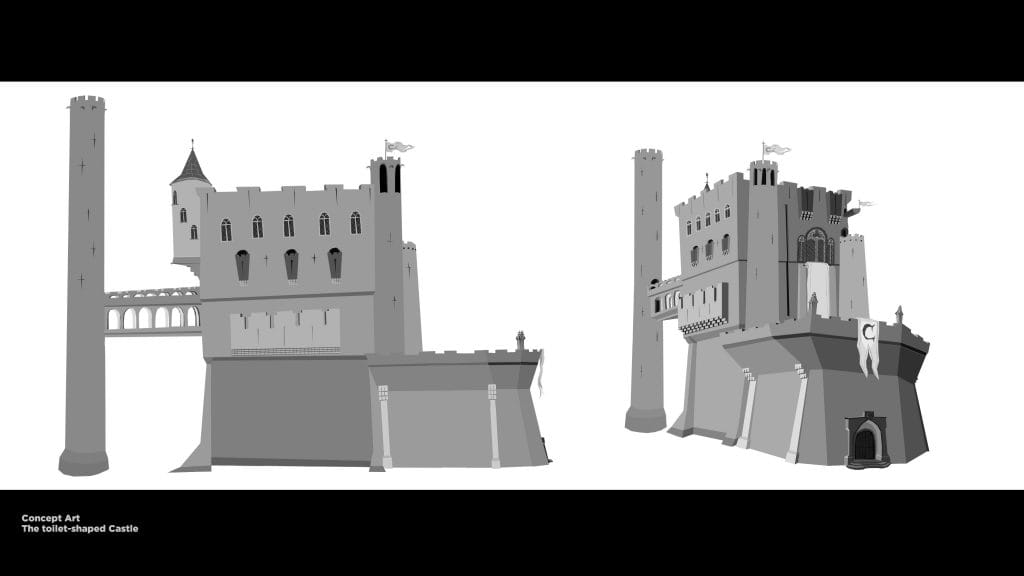
Will you use Harmony in the making of the project?
Roy: We’re still working on our visual development and storyboard/animatic for now, but our lead 2D animator will however be starting a couple of animation tests next week. Actual Animation will not be starting before October next.
What was the most important thing you all learned during the making of The Throne?
Roy: Finding a balance between being friends and being teammates. We found communication to be more challenging in the context of making a film together. It’s not easy to co-direct a short film, especially when all 5 of us have different artistic tastes and preferences… I’m certain we will face more challenges along the way but for now, we’re focused on being honest and speaking our minds instead of keeping our opinions to ourselves. All the while being wary of our phrasing and tone, staying professional is a priority.
What was the biggest challenge during the making of The Throne?
Roy: I think one of the biggest challenges we’ve faced this far is getting our visual design right. We don’t exactly have the same art styles and finding a mix of those or a middle ground that also works in favor of the story we’re telling is painstakingly difficult. We’re still figuring out what direction our film will take on. We have the story, the jokes and the narrative rhythm. We’re now working on ways to find our visual identity.
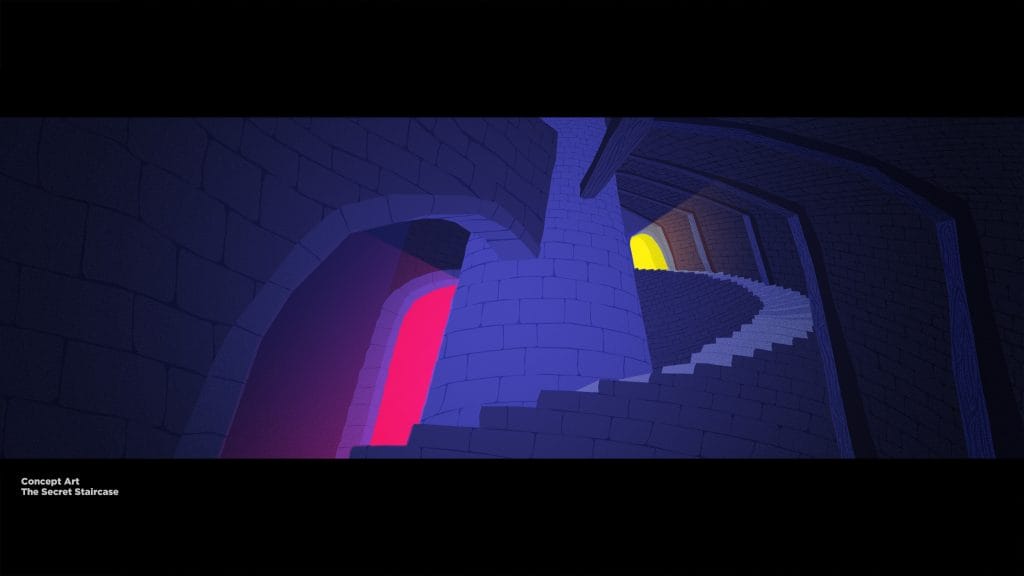
Tell us about your time on the animation programme at ECV Bordeaux?
Roy: Each year has been better than the one before at ECV Bordeaux. We can really feel ourselves growing and mature and our artistic expression gaining in confidence. Before the start of this semester, we would have assignments to complete before a set deadline. Background design, storyboarding, character design, concept art, 2D animation… Exercises we did individually and sometimes as a group or duo. Our teachers have all worked in the industry and some are still actively working with studios or as freelancers, so their input and knowledge is very much relevant and useful.
With the beginning of this current semester, regular classes have stopped and our short film is the main focus. Every other week, the school invites a professional who sets up their own workshop (so far, we have met up with 2D animators, a director, a props artist, a concept artist). Together, we work two consecutive days on our end of year project. It’s an opportunity for the team to pitch our short film to people and see their reactions. It’s also refreshing to get a different perspective on the work we did so far.
- Interested in learning more about ECV’s animation programs in Paris, Bordeaux, Aix-en-Provence, Nantes and Lille? Be sure to visit the school’s official website.
- Planning your thesis film? Students can get up to 84% off discounts on Harmony and Storyboard Pro with student licenses.


